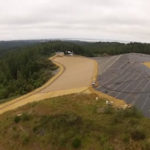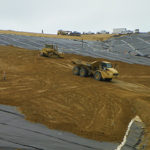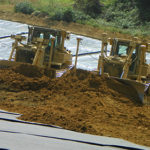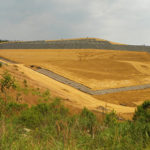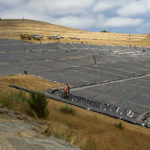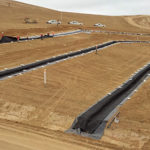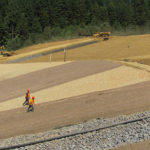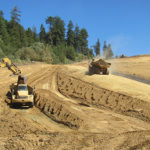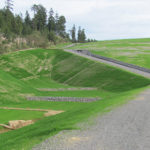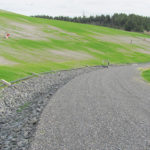Problem
The Cummings Road Landfill, located near Eureka, Humboldt County, California, opened in the early 1930s and was, for many years, a burn dump operation. Garbage that was collected in Eureka and its surroundings was transported to the site where it was burned. The ash and other remaining material were then landfilled into the surrounding ravines. This practice continued until 1969, at which time a portion of the site was converted to an unlined canyon landfill. By 1998, the landfill ceased accepting waste with the intent of closure.
In 2000, the Humboldt Waste Management Authority (HWMA) became the new owners of the Landfill. Over the next few years they implemented closure permitting and closure construction activities culminating with a 21-acre Phase 1 closure cap construction in 2012. In 2014, placement of the remaining burn-ash debris from the adjacent burn-ash debris site in the landfill took place, followed by a 12-acre Phase 2 closure cap construction project in 2015. The capping system consisted of (from bottom to top) a 24-inch thick compacted soil “foundation layer,” 60-mil linear low-density polyethylene (LLDPE) geomembrane, a geocomposite drainage layer, and an 18-inch soil “vegetative layer.”
There were several challenges associated with this landfill. First, it encompassed a sizable area of approximately 33 acres. Second, most of the landfill surface consisted of sideslopes ranging between 3 to 1 and 4 to 1 (horizontal to vertical dimension). Because a portion of the landfill has a Subtitle D liner, the State of California Regional Water Quality Control Board required that a geosynthetic layer be incorporated into the closure cap for the entire landfill.
To complicate matters, available on-site soil that would be used to construct the soil vegetative layer had a consistency resembling fine sand with very low cohesiveness. Because the Eureka area receives an average of 40 inches of rainfall per year, the potential for erosion after construction and prior to establishing erosion control seeding was of significant concern.
Solution
Because the on-site soil was very permeable and erosive, the owner brought in Lawrence & Associates to design a robust cap drainage system to prevent a buildup of pore pressure that could cause erosion of the vegetative layer. To drain water from the bottom of the vegetative layer, a drainage layer was built into the cap. A series of drainage trenches (cap drains), spaced every 50 feet of slope length between the benches on 4 to 1 sideslopes and every 75 feet on 3 to 1 sideslopes, was incorporated into the cap to collect water from the drainage layer and route it off the cap.
Due to the site-specific soil composition, slope angle, and slope length, the geocomposite drainage layer transmissivity was required to be equal to or greater than 5 x 10-4 m2/sec (MARV). Tests on AGRU America’s Super Gripnet system showed a transmissivity of 7.1 x 10-4 m2/sec using site-specific soil and loading in the tests.
For the Phase 1 closure project, the owner requested bids for the geomembrane and drainage layer components consisting of either (1) AGRU’s 60-mil LLDPE Super Gripnet combined with an 8-oz/sq. yd. nonwoven geotextile, or (2) a traditional conventional 60-mil LLDPE double-sided textured geomembrane overlain with a 300-mil two-sided geocomposite drainage layer. The Super Gripnet option was found to cost 8% less than the other method and, based on these results, the design team implemented AGRU’s Super Gripnet solution instead of using the traditional approach. The Super Gripnet’s performance and cost ultimately made it the solution of choice for the team.
The Phase 1 work included clearing, stripping, and re-grading the “Toe” of the landfill (the portion consisting of extensive sideslopes), and r-compacting 74,500 cubic yards of existing soil to create the foundation layer. To prepare for cap placement, the existing methane-gas-well risers were raised or lowered to avoid obstruction. After construction of the foundation layer, approximately 10,700 lineal feet of cap-drain trenches where excavated. Additionally, 7,400 lineal feet of drainage ditches were incorporated into the foundation layer.
The AGRU Super Gripnet and nonwoven geotextile were installed over the Phase 1 closure foundation layer. Meanwhile, approximately 10,700 lineal feet of perforated pipe and rock for the cap drains were installed and capped with 8-oz nonwoven geotextile. About 59,000 cubic yards of vegetative-layer soil was placed over the geomembrane and drainage system. To avoid damaging the underlying geomembrane, low ground pressure equipment hauled and placed the soil cover.
The drainage ditches were lined with rock riprap to collect and divert surface runoff to the perimeter of the landfill. To protect exposed geotextiles from heavier equipment, about 3,400 tons of aggregate base rock was placed for site access roads. The entire site was hydro-seeded before straw and jute netting were placed on slopes to protect the surface until the grass established itself. The Phase 1 closure project was completed in late 2012.
In 2014, the owner completed clean closure of the remaining exposed burn-ash debris from property adjacent to the landfill. The burn-ash debris was placed in the flatter top deck area of the landfill (future Phase 2 closure area). The ability to transfer the burn-ash debris to the top of the uncapped portions of the Landfill allowed the team to reduce the ash cleanup cost by $8.5 million (as compared to hauling the material to another landfill). After the ash was hauled, it was covered with 6 inches of clean intermediate cover soil and then protected with seed, straw, and other temporary erosion control until it was capped during the Phase 2 closure project.
With the Phase 1 cap system functioning well for the two winters following construction, the team decided to continue using the AGRU Super Gripnet system for the Phase 2 closure. For the Phase 2 project, the contractor first created a haul road to transfer clean soil to the work area, then re-contoured the landfill surface slightly, re-compacted the existing soil cover, and added another 18 to 24 inches of compacted soil to create the foundation layer. While exposing the edge of the base liner, waste was encountered and required moving some waste to the top deck of the landfill. The Phase 2 capping project was completed using similar methods to those described for the Phase 1 capping project above.
Outcome
This landfill closure utilized AGRU America’s proprietary Integrated Drainage System (IDS) geomembrane vs. a standard textured LLDPE and geocomposites.
Jute netting was used for initial erosion control on the vegetative layer. Thanks to the erosion-control measures in addition to the IDS-based robust cap drainage system, erosion during the first winter after construction (and subsequent winters) was negligible and the water exiting the cap drains was essentially clear with lower turbidity than runoff from surrounding vegetated native soil. The IDS cap system used in both Phase 1 and Phase 2 has functioned well in the years following construction.
The project used over 1.5 million square feet of LLDPE 60-mil AGRU Super Gripnet and 8-ounce non-woven geotextile. Clayton Coles of Lawrence & Associate (Redding, California) designed the project with Anderson Dragline serving as general contractor for the Phase 1 closure cap with Meyers Earthwork serving as general contractor for the Phase 2 closure cap. The Phase 1 geomembrane installation was completed by D & E Construction, Inc. The Phase 2 geomembrane installation was completed by International Lining Technology.
Citation
Faulkner, Jessie “Final closure of Cummings Road Landfill slated for this summer.” Times-Standard News. (2015). electronically accessed March 2017. http://www.times-standard.com/article/NJ/20150607/NEWS/150609880.
Overview
- Project Name: Cummings Road Landfill
- Location: Eureka, California
- Completion Date: Phase 1 (2012) and Phase 2 (2015)
- Products Used: AGRU Super Gripnet, AGRUTex
Download Resources
Need Help Determining Which Product is Right For Your Application?
Interested in learning more about how one of our products can make a difference in your next project? Please reach out to us with your questions and one of our sales or technical staff will be happy to assist you.
We can help you determine your exact product or application-related needs. And because our products meet, and often exceed, industry standards you can rest assured knowing that you are getting the best solutions in the business.
